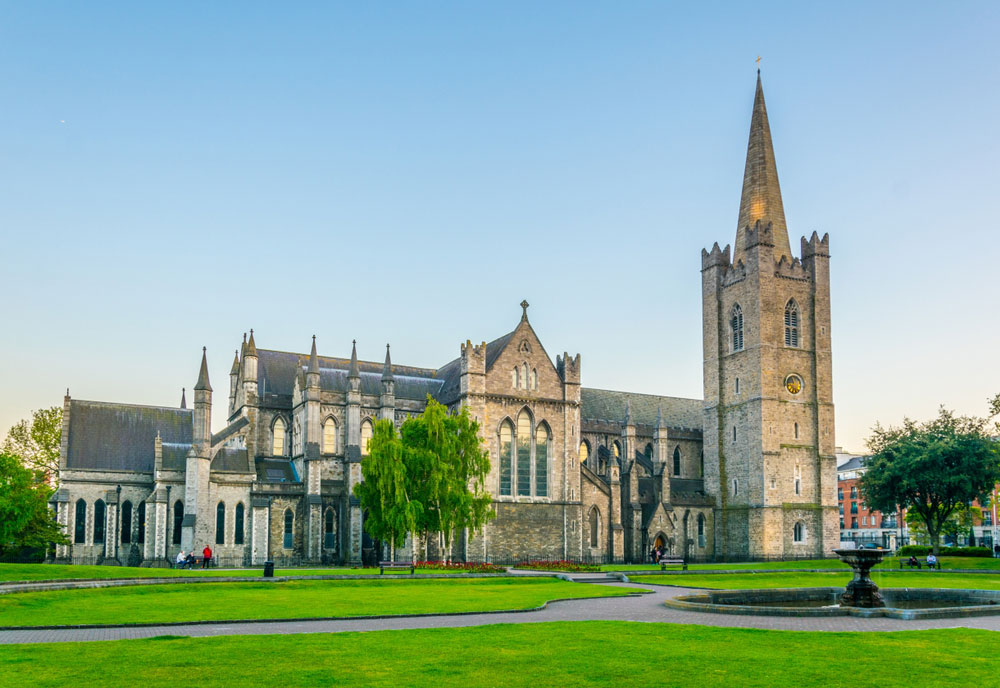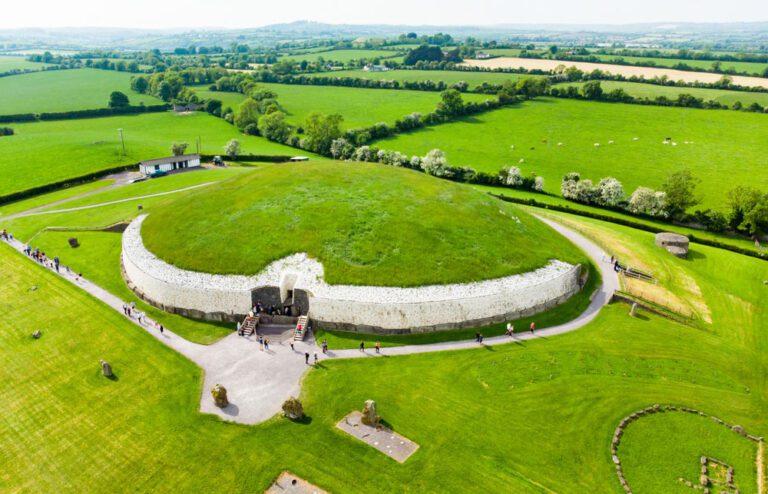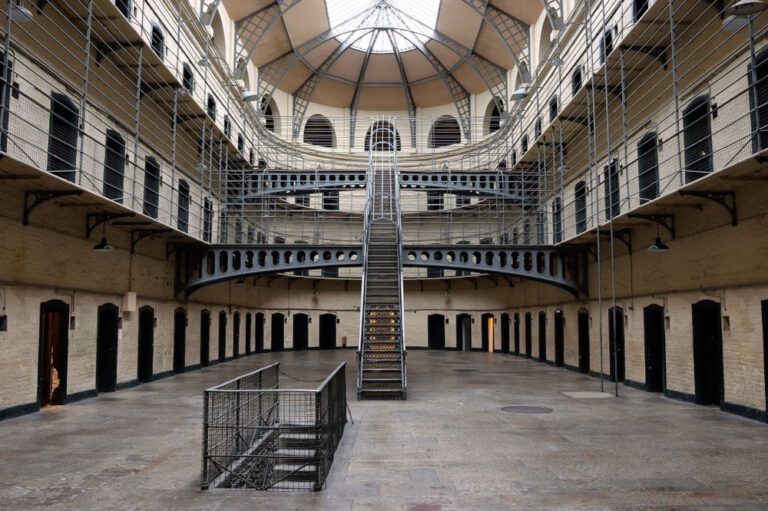St. Patrick’s Cathedral’s History
St. Patrick’s Cathedral is one of Dublin’s most recognizable sights. It is a magnificent edifice that has been at the center of Irish history for almost 800 years. The cathedral has seen numerous alterations throughout the years, yet it still remains as a symbol of Irish identity and culture.
The oldest reference of a church on the site of St. Patrick’s Cathedral is from the fifth century. The existing building, on the other hand, was erected between 1191 and 1270. The cathedral’s initial goal was to serve as a place of worship for the Anglican Church of Ireland.
St. Patrick’s Cathedral has experienced several alterations and reconstructions over the ages. The cathedral was expanded and a new nave was erected in the 14th century. The structure was also harmed during the Protestant Reformation, when the Church of Ireland seceded from the Roman Catholic Church. The cathedral fell into ruin during this period and was finally shuttered for a while.
The cathedral was renovated and reopened in the 17th century. During this time, the famous writer and clergyman Jonathan Swift was appointed Dean of St. Patrick’s Cathedral. Swift is noted for his numerous contributions to the cathedral, notably his well-known sermon, “A Modest Proposal,” delivered in 1729.
St. Patrick’s Cathedral has played an essential part in Irish history throughout its history. Many important events, such as coronations, funerals, and other ceremonies, have taken place there. For example, on his journey to Ireland in 1821, King George IV paid a visit to the cathedral. The structure has also been used as a hospital during times of conflict, notably the Irish Rebellion of 1641 and World War I.
St. Patrick’s Cathedral is still an essential element of Irish history and culture today. It is a renowned tourist site, drawing tourists from all over the world to admire the Gothic architecture and learn about its history. It also serves as a Church of Ireland worship center, conducting regular services and events throughout the year.
Architecture and Design
St. Patrick’s Cathedral is a magnificent example of Gothic Revival architecture, with exquisite detailing and lovely architectural features. The cathedral’s lofty spire, which rises to 140 feet and can be seen from many parts of Dublin, is one of its most outstanding features.
The cathedral’s elaborate architectural characteristics include pointed arches, ribbed vaults, and flying buttresses. The cathedral’s nave is especially striking, with a lofty vaulted ceiling and a succession of columns leading the eye to the altar. The cathedral’s interior is also ornamented with a variety of spectacular stained glass windows, many of which date back to the nineteenth century.
St. Patrick’s Cathedral has undergone several repairs and restorations throughout the years. Sir Benjamin Lee Guinness, an architect, significantly rebuilt the cathedral in the nineteenth century. The acquisition of a new organ and the restoration of many of the cathedral’s historic features were among Guinness’ restorations.
St. Patrick’s Cathedral recently had a large renovation project, which began in 2009 and was finished in 2013. The work included repairing and restoring the cathedral’s masonry, as well as installing new lighting and sound systems. The restoration work has contributed to the preservation of the cathedral’s distinctive architectural elements, ensuring that it remains a spectacular example of Gothic Revival style.
Visitors may now enjoy St. Patrick’s Cathedral’s spectacular architectural and design features while learning about its unique history. There are guided tours of the cathedral available, which provide visitors with a fuller understanding of the building’s distinctive characteristics as well as the vital part it has played in Irish history and culture.
Famous Figures Associated with the Cathedral
Throughout its long history, St. Patrick’s Cathedral has been associated with many famous figures, and their contributions have had a lasting impact on the cathedral’s significance and legacy. Writers such as Jonathan Swift and W.B. Yeats are among those who have been linked with St. Patrick’s Cathedral.
Jonathan Swift was a writer and dean of St. Patrick’s Cathedral in Dublin from 1713 until 1745. Swift made several contributions to the cathedral’s history during his stay there, including the creation of several notable works such as “A Tale of a Tub” and “Gulliver’s Travels.” He also delivered several sermons that shaped the cathedral’s theological and cultural significance.
W.B. Yeats is another notable writer linked with St. Patrick’s Cathedral. Yeats was a key player in the early twentieth-century Irish literary renaissance, and he had a strong association with the cathedral throughout his life. Yeats was christened and frequently attended services at St. Patrick’s Cathedral. In 1920, he also delivered a notable reading of his poem “Easter 1916” at the cathedral.
Irish leaders and statesmen such as Arthur Guinness and Daniel O’Connell are also affiliated with St. Patrick’s Cathedral. The founder of the Guinness company, Arthur Guinness, was a prominent member of the Church of Ireland and made several gifts to the cathedral’s care and renovation. Daniel O’Connell, a key player in Ireland’s independence struggle, was a frequent visitor to St. Patrick’s Cathedral and delivered several speeches there.
Overall, the renowned people affiliated with St. Patrick’s Cathedral have had a tremendous effect on the cathedral’s cultural and historical relevance. Their contributions have helped to shape the cathedral’s legacy as one of Ireland’s most significant and iconic landmarks. Today, visitors to the cathedral can learn about these famous figures’ lives and legacies, as well as the roles they played in shaping the cathedral’s history.
Visiting St. Patrick’s Cathedral
Those interested in history, architecture, or religion will enjoy a visit to St. Patrick’s Cathedral. Here are some pointers and recommendations to help you make the most of your visit:
- Best times to visit: St. Patrick’s Cathedral is open every day of the week, however it may get quite busy on weekends and during peak tourist season (June-August). To avoid crowds, try to visit during the off-season or on a weekday. With a few exceptions, the cathedral is open from 9:00 a.m. until 5:00 p.m., so plan your visit accordingly.
- How to get there: St. Patrick’s Cathedral is centrally positioned in Dublin, within walking distance of numerous other sites. You may simply stroll to the cathedral if you are staying in the city center. You may also take a bus, a cab, or use the Dublin Bike Share program.
- What to expect: St. Patrick’s Cathedral is a working church, so please respect people who are there to worship. While inside the cathedral, dress modestly (no shorts or bare shoulders) and speak quietly. The cathedral has an entry cost, but it is well worth going to view the gorgeous architecture and learn about its history.
- Highlights of a visit: A tour of the cathedral and attending a service or performance are two of the numerous attractions of a visit to St. Patrick’s Cathedral. The cathedral provides daily guided tours, which are a terrific opportunity to learn more about its history and architecture. Throughout the year, the cathedral hosts concerts and other events, so check the schedule to see if there is anything special going on during your visit.
In addition to these highlights, visitors can also explore the cathedral’s beautiful stained glass windows, intricate stone carvings, and impressive pipe organ. The cathedral also has a gift shop and café, where visitors can purchase souvenirs and grab a bite to eat.
Overall, a visit to St. Patrick’s Cathedral is a must-do for anyone interested in Irish history, architecture, or religion. With a little planning and preparation, you can have a wonderful experience exploring this iconic landmark.
The St. Patrick’s Cathedral Legacy
St. Patrick’s Cathedral has an extensive history that goes beyond its historical relevance. It is Ireland’s largest church and has a significant position in the country’s culture and tradition. Here are some ways that the cathedral’s legacy lives on today:
- Tourist attraction: St. Patrick’s Cathedral is one of Dublin’s most prominent tourist sites, drawing tourists from all over the world. Many people visit the cathedral because of its stunning Gothic Revival architecture, exquisite stained glass windows, and historical significance. Throughout the year, the cathedral offers guided tours and hosts concerts and other events, making it an important cultural hub in the city.
- Venue for events: St. Patrick’s Cathedral has played an important role in Irish history as a venue for momentous events such as coronations, burials, and memorials. The cathedral is still used for significant events such as concerts, talks, and exhibits today. The gorgeous interior and acoustics of the cathedral make it a popular choice for musical performances, while its historical significance lends gravity to other sorts of events.
- Community outreach: St. Patrick’s Cathedral participates in community outreach projects in addition to its position as a tourist attraction and event location. Throughout the year, the cathedral hosts a variety of events and activities, such as homeless services, concerts for the elderly, and children’s workshops. These activities seek to foster a feeling of community and connection around the cathedral, ensuring that its legacy is felt for future generations.
- Inspiration for art and literature: St. Patrick’s Cathedral has inspired innumerable artists and authors throughout the years, including Jonathan Swift, W.B. Yeats, and James Joyce. Because of its stunning architecture, rich history, and spiritual importance, it has become a symbol of Irish culture and identity. The cathedral still inspires artists and authors from all over the world today, acting as a strong emblem of Ireland’s rich cultural legacy.
To summarize, St. Patrick’s Cathedral’s influence stretches well beyond its historical significance. The cathedral continues to play an important role in Irish culture and heritage as a tourist destination, event site, community center, and source of inspiration. Its long legacy demonstrates the power of art, architecture, and spirituality to alter our world and our lives.
Here are some more famous tourist attractions in County Dublin:
- Guinness Storehouse: A popular attraction for beer lovers, the Guinness Storehouse is a museum and brewery that showcases the history of Guinness and offers tasting experiences.
- Dublin Castle: A historic castle that has served as a fortress, royal residence, and government building over the centuries. It features beautiful gardens and architecture.
- Trinity College: A prestigious university founded in 1592, Trinity College is also home to the famous Book of Kells, an illuminated manuscript dating back to the 9th century.
- Kilmainham Gaol: A former prison that played a significant role in Irish history, including the 1916 Easter Rising. It’s now a museum that offers guided tours.
- Temple Bar: A lively and vibrant neighborhood filled with pubs, restaurants, and shops. It’s a popular spot for nightlife and entertainment.
- Kilmainham Gaol: A former prison that played a significant role in Irish history, including the 1916 Easter Rising. It’s now a museum that offers guided tours.
- Phoenix Park: One of the largest urban parks in Europe, Phoenix Park is home to Dublin Zoo, the residence of the President of Ireland, and many walking and cycling trails.
- National Museum of Ireland: A museum that showcases the history and culture of Ireland, with collections on archaeology, art, and natural history.
- Grafton Street: A famous shopping street in Dublin, Grafton Street is home to many high-end shops, street performers, and restaurants.
- Dublin Zoo: A popular attraction for families, Dublin Zoo is home to over 400 animals from all over the world, including tigers, elephants, and penguins.
Helpful Resources:
Recommended Reading:




